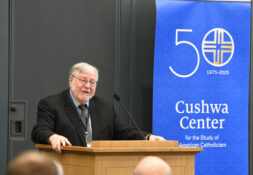Notre Dame community responds to success of Fifty Shades of Grey film
Valentine’s Day for college students usually consists of chocolate, Galentine’s day celebrations, nice Italian dinners, and stuffed animals that simply will not fit into a dorm room. For many college students this year, the celebration included (if you will excuse the expression) a striking addition: movie tickets to see the film Fifty Shades of Grey.
The book, now a major motion feature, conveys the story of a 21-year-old college student who meets a mysterious, rich man who practices Bondage and Discipline, Dominance and Submission, and Sadism and Masochism (BDSM).
The film made over 94 million dollars on opening weekend, the best-selling February opening to date. After five days, it surpassed the record set by The Passion of the Christ. In addition to the critical acclaim, however, there are many critical critics, including from traditional, conservative, family-values homes and from left-wing, liberal, fourth wave feminists. People object to the movie because of its portrayals of relationships, women, and BDSM.
Observer Assistant Managing Editor Sam Stryker wrote in the paper’s February 21, 2012, issue, “You can argue back and forth whether the series empowers women or not—the important thing is the discussion of sex and relationships is on the table … this is a discussion we Notre Dame students should be having. Parietals and SYR Dances have done their damage to gender relations here—wouldn’t it be nice to have a healthy conversation about sex and relationships on campus?”
The Rover investigated the opinions of others on campus regarding the Fifty Shades of Grey franchise.
Catherine Sullivan, senior English writing and Italian double major at Saint Mary’s College, expressed that the franchise does not depict a healthy relationship. She told the Rover, “There is no getting around the fact that the man idolized in these books and film is abusing [protagonist] Anastasia. This has less to do with sex than people are suggesting, and more to do with the fact that he shows up at her apartment, at her work, tracks her phone, and messes with her emotions. I have had friends with experiences all too similar to the one being paraded as a love story, when in fact it is a nightmare and a reality for so many.”
Maggie Skoch, president of Notre Dame’s chapter of the National Alliance on Mental Illness, also spoke with the Rover: “The franchise is affecting our society in two significant ways. First, it is confusing women and men alike about the beauty of sex. It promotes the notion that violence and sex belong together, so long as consent exists. It tells the world that porn isn’t porn if it is shown in a movie theater or is depicted in words. It teaches us that if you dress an abuser in a suit and put millions of dollars in his bank account, this behavior is no longer abuse.
“The second way in which this franchise is affecting today’s society is particularly disturbing in light of my work with NAMI-ND,” Skoch continued. “The main characters in Fifty Shades of Grey present a variety of emotional issues that ought to be dealt with by a mental health professional, not distorted and misrepresented by Hollywood … In addition to stigma, one of the biggest issues facing the world of mental health is a lack of education among the general population. This franchise promotes the continuation of ignorance.”
Alison Leddy, founder of Notre Dames—a student organization centered on sisterhood and addressing women’s issues—told the Rover, “Ultimately, the type of relationship in the novel is not one with consistently consenting partners nor emotionally stable individuals. In a society in which one in four women will experience domestic violence, the topic of healthy relationships is incredibly important to depict and discuss, especially in response to Fifty Shades.”
One anonymous Notre Dame student told the Rover, “The book doesn’t actually portray the BDSM community because the community actually has a set system of comfort and care. You would never leave your partner crying or uncomfortable, and everything is very mutual. It’s not something you don’t want. But in the book there are several times when he says, ‘You can scream and I’ll gag you’ … it’s an abusive relationship, putting someone who is portrayed as innocent or inexperienced in situations that are dangerous to her physical and mental wellbeing with no aftercare.”
Skoch also spoke to those considering going to the movie. “Recognize that there are many people in this world who have experienced the abuse featured in this movie,” she said. “We are doing them no favors by allowing this inaccurate portrayal of the hell of abuse infiltrate our perceptions.”
“We must be careful not to glamorize or encourage abusive relationships,” Leddy agreed. “Within Notre Dames, we often take a critical look at pop culture because it can have a tangible effect on our societal ideals and our lives. Being active and aware consumers can make a huge difference in the impact of novels, films, and other elements of pop culture.”
Many in the Notre Dame community critique the film for its portrayal of violence and sex and its representation of BDSM, but others on campus have criticized the film even more bluntly: “All in all, the surprisingly low amount of sex scenes certainly undermines the film’s hype” (Observer, February 20, 2015).
Whether it has a high enough number of sex scenes or not, Fifty Shades of Grey is bound to create more controversy as franchise owners consider making the second and third books into films.
Abigail Bartels is a junior in Badin Hall. She would advocate replacing Christian Grey with Sydney Carton any day of the week; “I would embrace any sacrifice for you and for those dear to you” sounds much better than “Laters, baby.” Contact her at abartel2@nd.edu.






Leave a Reply